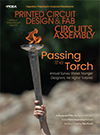News
News
Wave Soldering Facts and Fiction
Published: 04 January 2007
by Chrys Shea
Our newest columnist takes on the myths of the solder bath.
When wave solder alloy conversion issues emerged a few years ago, a number of rumors about the new process began circulating. Some were based on fact, some early speculation, and some just pure fiction. Two years later, with many mainstream assembly processes having converted to Pb-free, it was a surprise to find that many of the Pb-free wave soldering myths still circulated. It’s time to set the record straight.
Myth 1: Pb-free dross sinks to the bottom of the solder pot. Pure fiction. As with SnPb or any metal oxide, dross becomes less dense than is the molten metal and rises to the top. Around the globe, tens of thousands of wave solder operations have been converted to Pb-free alloys, and none has demonstrated dross sinking to the pot bottom. Similar to SnPb, it is typical for some dross to circulate in the melt, and a portion will cling to internal parts of the solder pot. Following an alloy conversion, preventive maintenance should be performed in the same manner and frequency as for a SnPb solder pot; maintenance intervals can then be adjusted based on production experience with the new process.
Myth 2: Float-type stainless steel solder level devices will no longer float and need to be replaced. More fiction. Because of differences in the density between lead-bearing and Pb-free alloys, floats do have less buoyancy in Pb-free solder. Take a moment to consider float design: There is typically a float surface, a fulcrum to pivot on, and a counterbalance. To accommodate for density difference, sensors simply need to be adjusted, which can be achieved by increasing the float surface area, by shifting the fulcrum position, or by adding weight to the counterbalance. This tried-and-true design is by no means obsolete.
Myth 3: Avoiding OSP surface finishes will limit copper dissolution. This is fiction (mostly). Copper dissolution has serious implications on both the soldering process and final product reliability. It is a hot topic in the engineering community, and many investigations of the phenomena are underway to quantify the issues. Whether the surface finish is OSP, immersion silver or immersion tin should not make a substantial difference. These final finishes immediately enter into solution when wetted by molten solder. ENIG is the only finish that should not lose copper to the solder bath, because the nickel barrier shields the copper from the wave. Recall that in the case of an ENIG finish, the solder is not attaching to copper, but to nickel instead, which brings with it a separate set of concerns for the engineer.
Myth 4. Bismuth embrittles Pb-free solder joints and should be avoided. To the contrary, bismuth in amounts up to 2% actually improves alloy fatigue strength. Pure bismuth is a brittle metal and when alloyed with tin at SnBi58, it makes a very brittle alloy with a melting point of 138°C. We assume that this is the root of one of the fears regarding bismuth inclusion. The other rumor-driven fear concerning bismuth:
Myth 5: Bismuth from solder can combine with SnPb to form an alloy that melts at 96°C. If any of the many components on a PWB is plated with SbPb, the entire assembly may be unreliable if service temperatures exceed 96°C. Nope. While it is true that an alloy containing 52% bismuth, 16% tin and 32% lead will melt at 96°C, it would be physically impossible to arrive at this concentration of bismuth, given that the bismuth component of solder alloys are typically 2% or less. Bismuth has a well-established history in both SnPb and Pb-free soldering. It is likely that the average American owns devices that contain bismuth in their SnPb (62/36/2) solder joints because it is used in one of the most popular consumer brands. Of three large-scale, major OEM studies, the most conservative results recommend bismuth in quantities less than 0.3%; compare this with the concentration of a typical Bi-containing Pb-free alloy at 0.1%.
Not sufficiently convinced? Take a look at the spec sheets for SnPb solder. Standard electronics-grade SnPb solders allow up to 0.1% bismuth in the alloy. History can provide some sound guidance. If bismuth inclusion presented reliability issues, these issues would have reared their ugly heads sometime in the past 50 years. The engineering community would be well aware of the reliability risks by now, and tighter specification limits would be in force for SnPb alloys.
What is this month’s lesson learned? Do not abandon the scientific principles you have employed for years. Although rumors on surface finishes and bismuth inclusion required consultation with metallurgists for clear-cut explanations, the concerns on dross buoyancy and stainless steel floats can be reasoned with some basic principles from high school chemistry and physics. While we can expect the behaviors of the new alloys to change as their constituents change, we cannot expect the laws of nature to change with them.
References
- The original wave soldering process was patented in 1956 by Fry’s Metals. The term flow soldering was a registered trademark of Fry’s Metals.
Chrys Shea is R&D applications engineeing manager at Cookson Electronics Assembly Materials. She spent 10 years as a surface mount process engineer at Motorola, Siemens, Texas Instruments and Compaq Computer, and holds a master’s in manufacturing engineering; chrysshea@cooksonelectronics.com.







